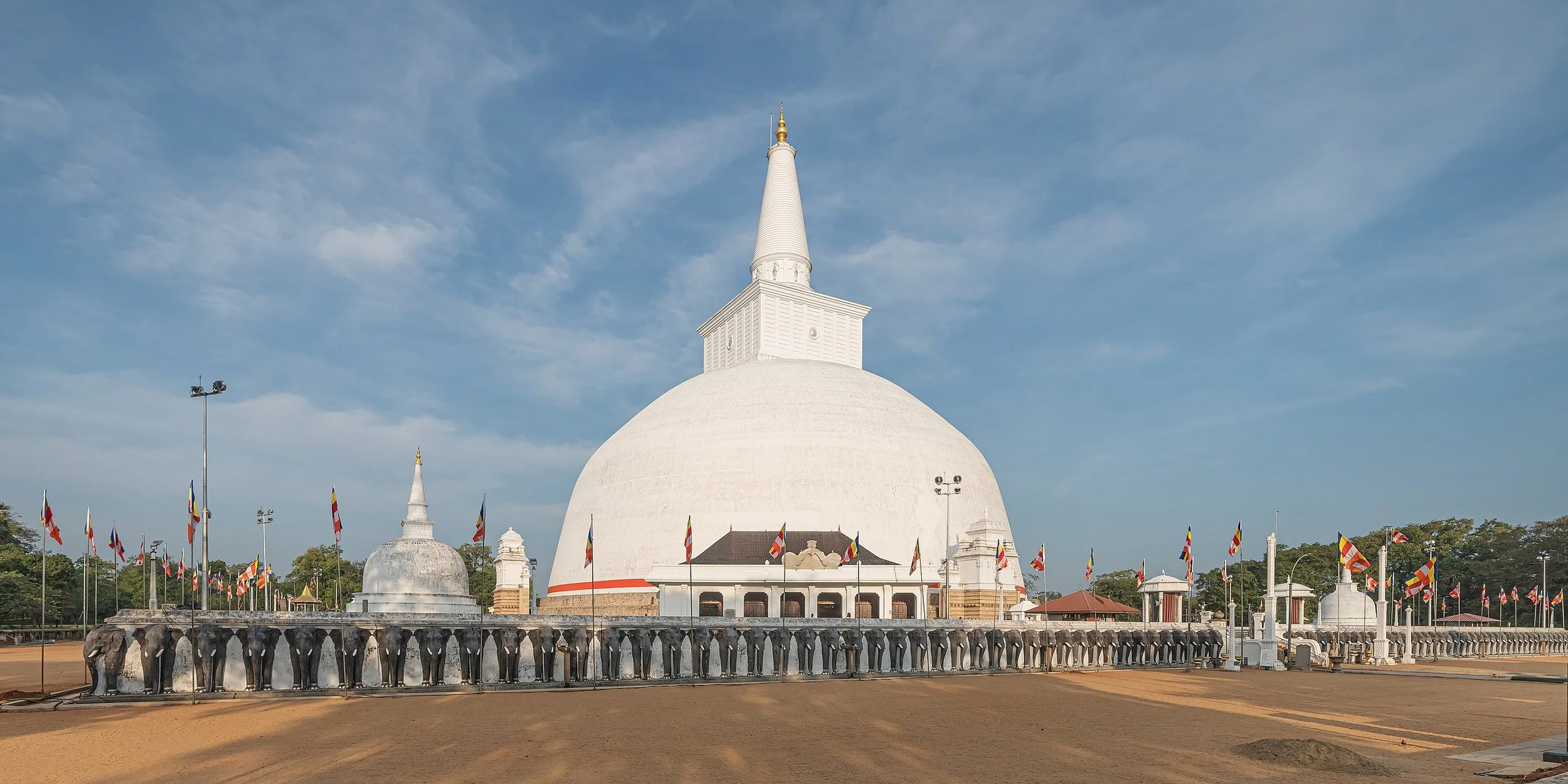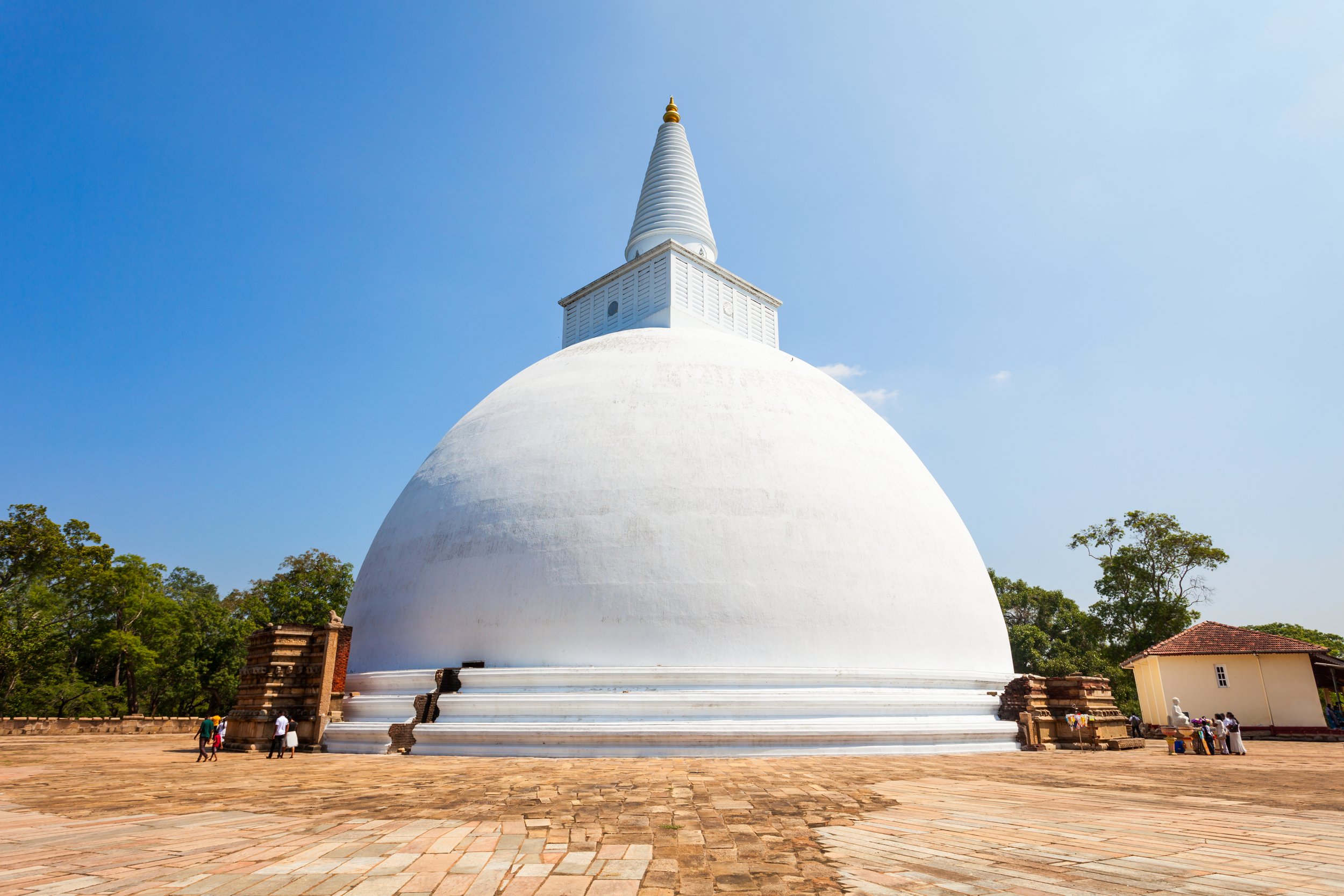Anuradhapura Part 2: Mirisawetiya, Ruwanweli Maha Seya, & Lovamahapaya
At a Glance
The following sites are all within a short distance of each other in the sacred ancient city of Anuradhapura, each having their own unique story and significance in the establishment of Dharma in Sri Lanka. The Mirisawetiya Stupa (A,S) houses a spear containing the Buddha's relics, the Ruwanweli Maha Seya (A,S) features the largest collection of the Buddha's relics in one place, and the Lovamahapaya (A) displays the remains of what was once the unmatched Sinhalese architecture known as the “Brazen Palace.”
Mirisawetiya Stupa (A,S)
At this site, King Dutugemunu built this stupa containing relics of the Buddha in the 2nd century BCE. While one legend claims this stupa was build as an apology by the king for failing to offer a portion of his meal to the monks before he consumed it (a vow he had maintained up till that point), another story tells of the king building the stupa in celebration of his victory over King Elara. This version tells of the king planting his battle spear containing relics of the Buddha in the ground, and later being unable to remove the spear due to its incredible power. The stupa was built to enshrine this sacred object.
Click here for map link
The Story
King Dutugemunu (r. 161-137 BCE) built the Mirisawetiya stupa. It is one of the many stupas located in the sacred city of Anuradhapura. Currently, this stupa is about 59 meters in height and 42 meters in diameter. Some historical records state that this stupa belongs to the Mahavihara monastery, but that is not certain.
There are two famous legends attached to the Mirisawetiya Stupa. According to one of the legends, King Dutugemunu took a vow to himself that whenever he consumed food, he would first offer some to the monks. However, once he forgot to do that while eating chili (locally called ‘Miris’) curry. As an apology for this mistake, he built this stupa and dedicated it to the monastery. Thereafter the stupa was named ‘Mirisawetiya.’ Today, to the northwest of the stupa, are some imposing columns, the chapter house of the Mirisaweti, and to the north is its refectory with a curry trough which holds a thousand servings.
The chronicle records that King Duthagamani built it in gratitude for his victory over King Elara in 158 B.C. During the ensuing celebrations, the King went to bathe in the Tissa Wewa during a water festival. As he bathed, he planted his spear in the ground, where he left his clothes and belongings. This standard contained relics of the Buddha inside the shaft and had brought him good fortune and success in his struggle to liberate his country from foreign oppression. After enjoying his time in the water a whole day together with the women of the harem, he said in the evening, “We will go hence, carry the spear before us.” However, no one could succeed in moving the standard from its location. Thus, the king decided to build a stupa enclosing this important relic.
Throughout the centuries, a number of kings renovated and restored the Mirisawetiya Stupa. With these renovations, the height and diameter of the stupa have changed. According to the history of Anuradhapura, during the Chola invasions, this stupa has been abandoned and ruined but never destroyed. The whole construction collapsed in 1987. The stupa pilgrims see today was completed in 1993 and encloses the remains of the original shrine but has unfortunately covered up all historic features of the original stupa.
Coordinates 8° 20′ 42″ N, 80° 23′ 20″ E
Ruwanweli Maha Seya (A, S)
This sacred stupa is said to encapsulate the largest portion of the Buddha's relics anywhere in the world. The site itself was visited by the Buddha during his third visit to Sri Lanka, where he paused to rest.
Click here for map link
The Story
Ruwanweli Maha Seya (A, S) also known as the Mahathupa (the Great Thupa) is another important stupa in Anuradhapura. It is one of the world’s tallest ancient monuments and was famous throughout Asia. It stands 103 m high and has a circumference of 290 m.
Once again, eight years after Shakyamuni Buddha’s enlightenment, the Naga King Maniakkhika, invited him and 500 of his monks to the island. Through their magical powers, the entire assembly flew southwards from the Jetavana grove in India. And then,
“Sitting down together with five hundred Bhikkhus, the Samubuddha entered upon ecstatic meditations; he diffused his kindness to all quarters. Seven times the Buddha together with his followers attained mystical trance; at that place (subsequently) the Mahathupa was built, the most excellent cetiya. ”
The cetiya, or stupa, built on this site by the warrior King Dutugemunu (c. 140 BCE) was said to enshrine one dona (about 2 quarts) of the Buddha's relics from his cremation, said to be the largest cache of his relics anywhere. King Dutugemunu unified Sri Lanka after a war in which he defeated the Chola King Elara.
The Mahavamsa also recorded that the Buddha rested on the land where the stupa stands, during his third visit to Sri Lanka. During the reign of King Devanampiyathissa, the Arhant Mahinda foretold of the erection of this great stupa. King Devanampiyathissa then established a pillar stating this prophecy. Later King Dutugemunu saw this prediction, was delighted and ordered the stupa to be built. Legend says that a goddess named “Swarnamali” resided in a “Ran Thelambu” tree which was in the land plot where the stupa was built. She lost her habitat to the stupa, and thus the king named the stupa after her.
According to the Mahavamsa, numerous classes of beings attended the enshrinement of the relics into the Mahathupa in the Thupavamsa. Among them was the Naga king Mahakala who had previously guarded them. The relics were to be placed atop a golden throne crafted by Visvakarman the divine artificer. The throne was brought by Indra. Brahma offered his invisible umbrella of sovereignty. The arhat Indagutta created a metal canopy over the universe so that Mara will not interfere, as monks chanted the sutra pitaka. King Dutthagamani ceremoniously entered with the urn atop his head.
Just as he was about to place the urn on the golden throne, the relics rose into the air and took the physical form of the Buddha, with each of the 32 major signs and eight lesser signs of a great man. Just as the Buddha himself had done during his lifetime, the relic form of the Buddha then performed the twin miracle of fire and water. This specific miracle fulfilled the fifth of his death bed resolutions, and at that time 120 million gods and humans attained arhatship. Afterwards, the relics returned by themselves into the urn and they were placed in a chamber sealed with forty meter stone slabs.
Pilgrims offer flowers to the stupa every morning, noon and evening. In addition to these daily ceremonies, throughout the year, special types of rituals are performed such as ‘Kapruk Puja’ or ‘Kanchuka Puja’ where pilgrims cover the stupa with Buddhist flag material or monastic robe materials as a gesture of receiving blessings.
Some people believe this great stupa may have unknown importance apart from the religious value. This belief stems from its perfect alignment with the three stars in the constellation of Orion, namely Rigel, Al Nitak and Bellatrix together with the Mirisawatiya Stupa and the Jethavana Stupa.
Lovamahapaya (A)
Here one can witness the remains of one of the most signifigant learning centers and artichtural masterpieces of Sinhalese history. While only a series of pillars have withstood the last two millenia, one can envision the magnifisance and importance of the site.
Click Here for Map Link
Between the Ruwanweli Stupa and Sri Maha Bodhi is another sacred site called the Lovamahapaya (A). According to the chronicles it had a roof covered with bronze tiles. Therefore it became known as the ‘Brazen Palace’, or ‘Lohaprasadaya’.
The structure displays the rich ancient architectural knowledge of Sri Lankan people. In the 3rd century B.C., King Devanampiyathissa built a chapter house on the instructions by Arahat Mahinda Thero, who brought Buddhism to Sri Lanka. One hundred years later, King Dutugamunu redesigned it as a chapter house for the Mahavihara Monastery. It was a nine-storied, square-shaped structure with a height of 30m. The building was supported by 40 rows of stone pillars, each containing 40 posts, a total of 1600 components. They were decorated with corals and precious stones, and its roof was covered with bronze plates. All nine floors had apartments. The first floor was for the student monks. The second floor was for the monks who knew Tripitakaya. The third, fourth, and fifth floors were reserved for the monks who had achieved the first three levels of accomplishment (stream-enterer, once-returner, non-returner). The top four stories were for the monks who had reached the state of an arhat.
According to the Mahavamsa, a fire destroyed this building and it underwent several reconstructions. During the period of sectarian conflict, King Mahasena demolished the Lovamahapaya and gave its material to the Abayaghiri Viharaya after having a conflict with the monks in the Mahavihara. His son, King Sirimeghavanna, repentant for the mistakes of his father, rebuilt this palace. Over ensuing centuries, foreign invaders destroyed the palace several times. In the tenth century, the kingdon of Anuradhapura fell and it was left to ruin. In the 12th century, King Parakramabhu I raised the 1600 pillars again and partly restored it, leaving the remains that pilgrims witness today.




